Introducing Lean Project Management Principles: A Staff Memo
VerifiedAdded on 2023/03/23
|13
|3977
|73
Report
AI Summary
This document presents a staff memo regarding the implementation of Lean Project Management (LPM) principles within a project management consultancy aiming to secure government contracts. The memo outlines the reasons for adopting LPM, emphasizing the need to meet government project requirements and improve organizational efficiency. It details the benefits for both internal and external stakeholders, such as enhanced quality control, streamlined operations, and improved customer interaction. Critical Success Factors (CSFs) essential for successful LPM implementation, including organizational culture, skills and expertise, financial capabilities, and leadership, are discussed. The memo proposes steps to ensure these CSFs are in place, fostering an LPM mindset throughout the consultancy. The memo concludes by suggesting methods to assess the effectiveness of the implemented LPM principles, ensuring continuous improvement and alignment with organizational goals.
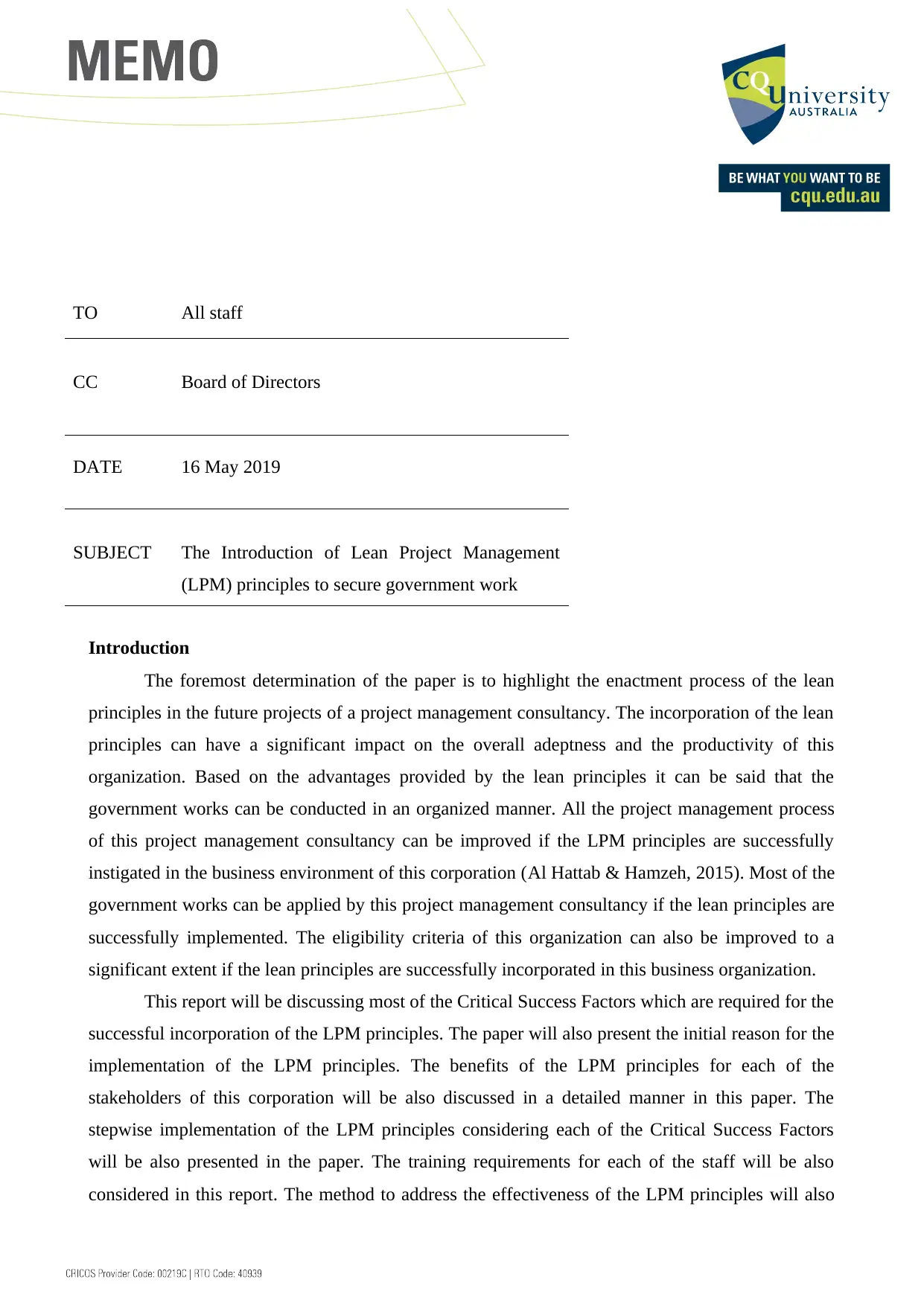
Introduction
The foremost determination of the paper is to highlight the enactment process of the lean
principles in the future projects of a project management consultancy. The incorporation of the lean
principles can have a significant impact on the overall adeptness and the productivity of this
organization. Based on the advantages provided by the lean principles it can be said that the
government works can be conducted in an organized manner. All the project management process
of this project management consultancy can be improved if the LPM principles are successfully
instigated in the business environment of this corporation (Al Hattab & Hamzeh, 2015). Most of the
government works can be applied by this project management consultancy if the lean principles are
successfully implemented. The eligibility criteria of this organization can also be improved to a
significant extent if the lean principles are successfully incorporated in this business organization.
This report will be discussing most of the Critical Success Factors which are required for the
successful incorporation of the LPM principles. The paper will also present the initial reason for the
implementation of the LPM principles. The benefits of the LPM principles for each of the
stakeholders of this corporation will be also discussed in a detailed manner in this paper. The
stepwise implementation of the LPM principles considering each of the Critical Success Factors
will be also presented in the paper. The training requirements for each of the staff will be also
considered in this report. The method to address the effectiveness of the LPM principles will also
TO All staff
CC Board of Directors
DATE 16 May 2019
SUBJECT The Introduction of Lean Project Management
(LPM) principles to secure government work
The foremost determination of the paper is to highlight the enactment process of the lean
principles in the future projects of a project management consultancy. The incorporation of the lean
principles can have a significant impact on the overall adeptness and the productivity of this
organization. Based on the advantages provided by the lean principles it can be said that the
government works can be conducted in an organized manner. All the project management process
of this project management consultancy can be improved if the LPM principles are successfully
instigated in the business environment of this corporation (Al Hattab & Hamzeh, 2015). Most of the
government works can be applied by this project management consultancy if the lean principles are
successfully implemented. The eligibility criteria of this organization can also be improved to a
significant extent if the lean principles are successfully incorporated in this business organization.
This report will be discussing most of the Critical Success Factors which are required for the
successful incorporation of the LPM principles. The paper will also present the initial reason for the
implementation of the LPM principles. The benefits of the LPM principles for each of the
stakeholders of this corporation will be also discussed in a detailed manner in this paper. The
stepwise implementation of the LPM principles considering each of the Critical Success Factors
will be also presented in the paper. The training requirements for each of the staff will be also
considered in this report. The method to address the effectiveness of the LPM principles will also
TO All staff
CC Board of Directors
DATE 16 May 2019
SUBJECT The Introduction of Lean Project Management
(LPM) principles to secure government work
Paraphrase This Document
Need a fresh take? Get an instant paraphrase of this document with our AI Paraphraser
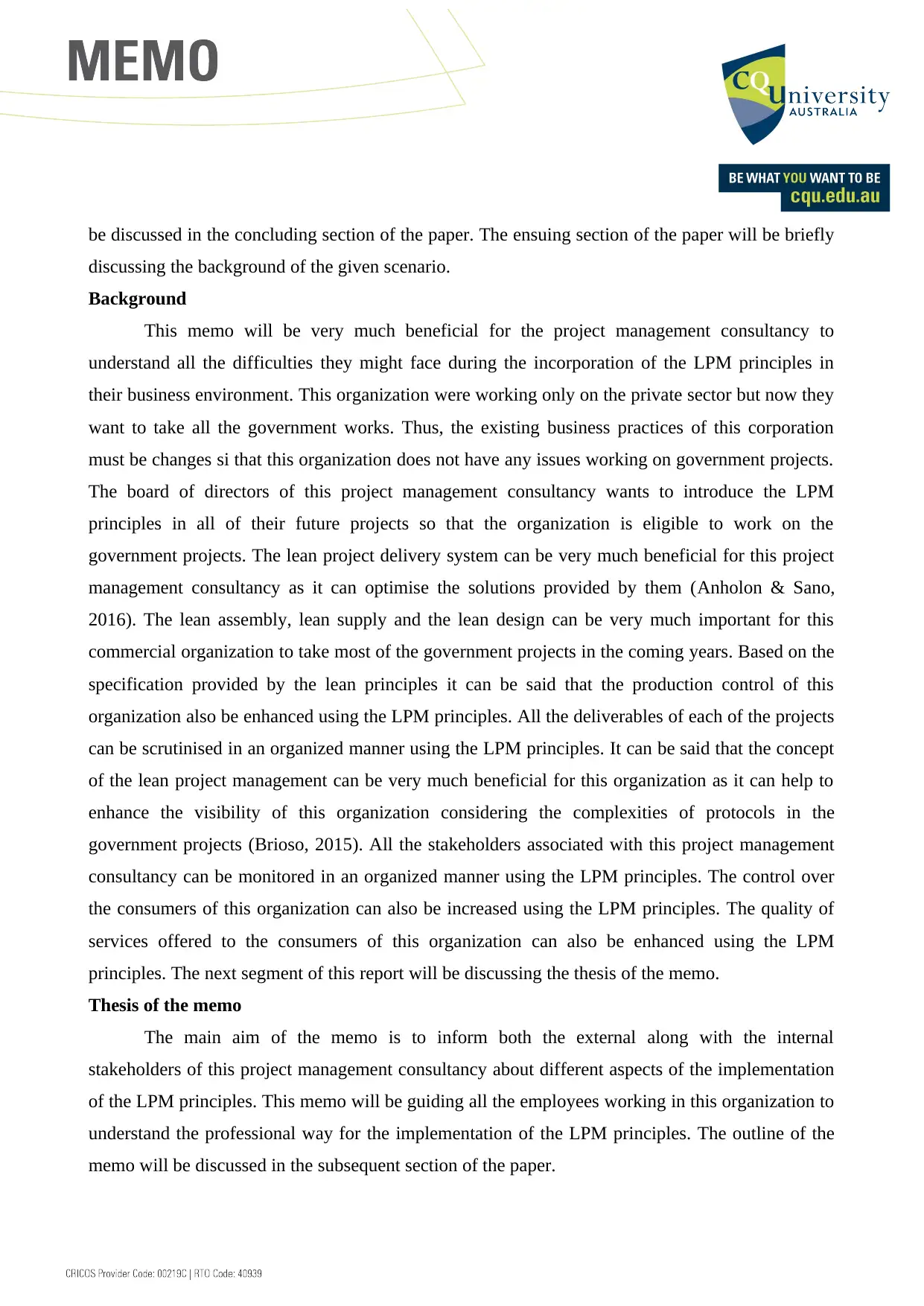
be discussed in the concluding section of the paper. The ensuing section of the paper will be briefly
discussing the background of the given scenario.
Background
This memo will be very much beneficial for the project management consultancy to
understand all the difficulties they might face during the incorporation of the LPM principles in
their business environment. This organization were working only on the private sector but now they
want to take all the government works. Thus, the existing business practices of this corporation
must be changes si that this organization does not have any issues working on government projects.
The board of directors of this project management consultancy wants to introduce the LPM
principles in all of their future projects so that the organization is eligible to work on the
government projects. The lean project delivery system can be very much beneficial for this project
management consultancy as it can optimise the solutions provided by them (Anholon & Sano,
2016). The lean assembly, lean supply and the lean design can be very much important for this
commercial organization to take most of the government projects in the coming years. Based on the
specification provided by the lean principles it can be said that the production control of this
organization also be enhanced using the LPM principles. All the deliverables of each of the projects
can be scrutinised in an organized manner using the LPM principles. It can be said that the concept
of the lean project management can be very much beneficial for this organization as it can help to
enhance the visibility of this organization considering the complexities of protocols in the
government projects (Brioso, 2015). All the stakeholders associated with this project management
consultancy can be monitored in an organized manner using the LPM principles. The control over
the consumers of this organization can also be increased using the LPM principles. The quality of
services offered to the consumers of this organization can also be enhanced using the LPM
principles. The next segment of this report will be discussing the thesis of the memo.
Thesis of the memo
The main aim of the memo is to inform both the external along with the internal
stakeholders of this project management consultancy about different aspects of the implementation
of the LPM principles. This memo will be guiding all the employees working in this organization to
understand the professional way for the implementation of the LPM principles. The outline of the
memo will be discussed in the subsequent section of the paper.
discussing the background of the given scenario.
Background
This memo will be very much beneficial for the project management consultancy to
understand all the difficulties they might face during the incorporation of the LPM principles in
their business environment. This organization were working only on the private sector but now they
want to take all the government works. Thus, the existing business practices of this corporation
must be changes si that this organization does not have any issues working on government projects.
The board of directors of this project management consultancy wants to introduce the LPM
principles in all of their future projects so that the organization is eligible to work on the
government projects. The lean project delivery system can be very much beneficial for this project
management consultancy as it can optimise the solutions provided by them (Anholon & Sano,
2016). The lean assembly, lean supply and the lean design can be very much important for this
commercial organization to take most of the government projects in the coming years. Based on the
specification provided by the lean principles it can be said that the production control of this
organization also be enhanced using the LPM principles. All the deliverables of each of the projects
can be scrutinised in an organized manner using the LPM principles. It can be said that the concept
of the lean project management can be very much beneficial for this organization as it can help to
enhance the visibility of this organization considering the complexities of protocols in the
government projects (Brioso, 2015). All the stakeholders associated with this project management
consultancy can be monitored in an organized manner using the LPM principles. The control over
the consumers of this organization can also be increased using the LPM principles. The quality of
services offered to the consumers of this organization can also be enhanced using the LPM
principles. The next segment of this report will be discussing the thesis of the memo.
Thesis of the memo
The main aim of the memo is to inform both the external along with the internal
stakeholders of this project management consultancy about different aspects of the implementation
of the LPM principles. This memo will be guiding all the employees working in this organization to
understand the professional way for the implementation of the LPM principles. The outline of the
memo will be discussed in the subsequent section of the paper.
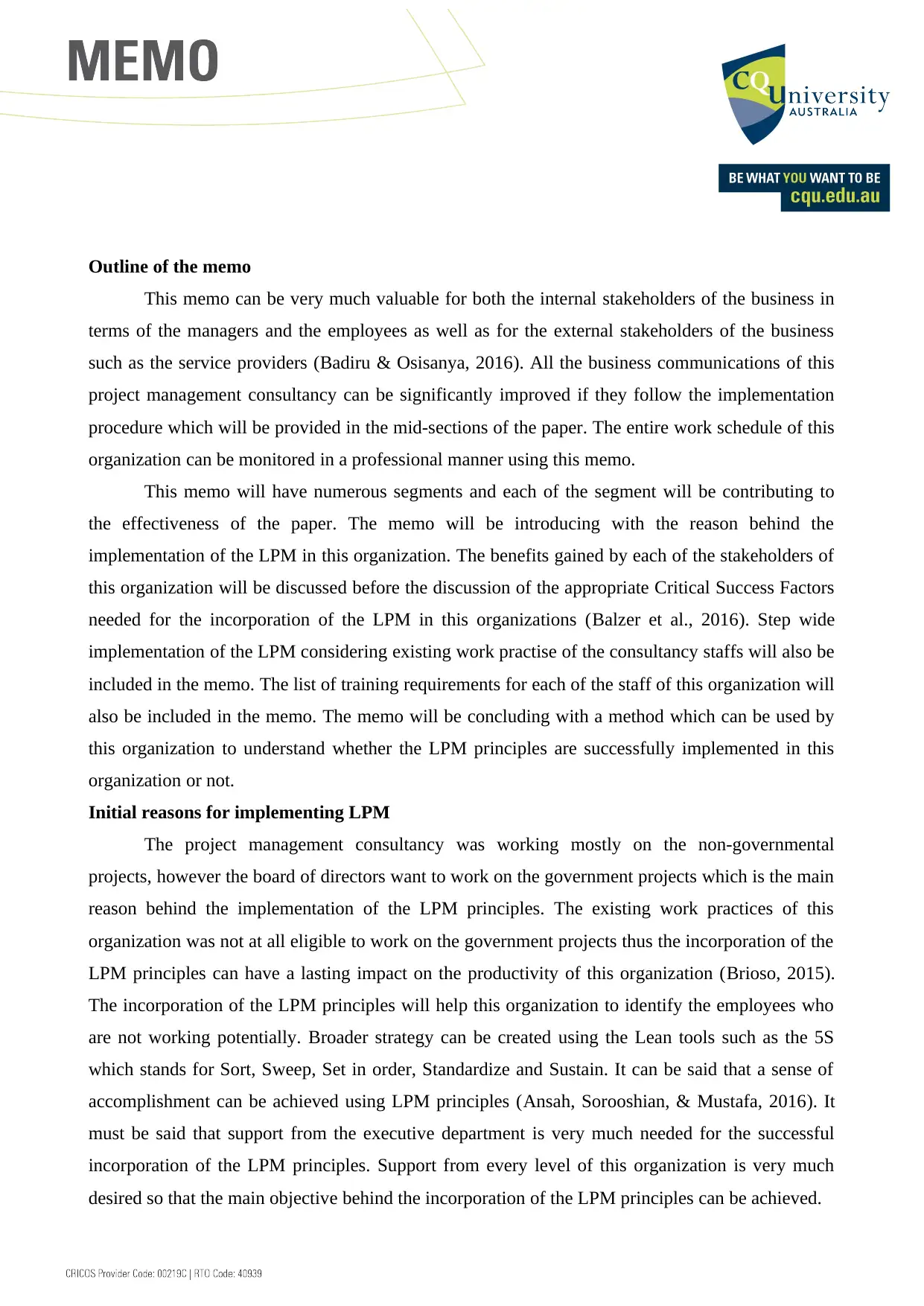
Outline of the memo
This memo can be very much valuable for both the internal stakeholders of the business in
terms of the managers and the employees as well as for the external stakeholders of the business
such as the service providers (Badiru & Osisanya, 2016). All the business communications of this
project management consultancy can be significantly improved if they follow the implementation
procedure which will be provided in the mid-sections of the paper. The entire work schedule of this
organization can be monitored in a professional manner using this memo.
This memo will have numerous segments and each of the segment will be contributing to
the effectiveness of the paper. The memo will be introducing with the reason behind the
implementation of the LPM in this organization. The benefits gained by each of the stakeholders of
this organization will be discussed before the discussion of the appropriate Critical Success Factors
needed for the incorporation of the LPM in this organizations (Balzer et al., 2016). Step wide
implementation of the LPM considering existing work practise of the consultancy staffs will also be
included in the memo. The list of training requirements for each of the staff of this organization will
also be included in the memo. The memo will be concluding with a method which can be used by
this organization to understand whether the LPM principles are successfully implemented in this
organization or not.
Initial reasons for implementing LPM
The project management consultancy was working mostly on the non-governmental
projects, however the board of directors want to work on the government projects which is the main
reason behind the implementation of the LPM principles. The existing work practices of this
organization was not at all eligible to work on the government projects thus the incorporation of the
LPM principles can have a lasting impact on the productivity of this organization (Brioso, 2015).
The incorporation of the LPM principles will help this organization to identify the employees who
are not working potentially. Broader strategy can be created using the Lean tools such as the 5S
which stands for Sort, Sweep, Set in order, Standardize and Sustain. It can be said that a sense of
accomplishment can be achieved using LPM principles (Ansah, Sorooshian, & Mustafa, 2016). It
must be said that support from the executive department is very much needed for the successful
incorporation of the LPM principles. Support from every level of this organization is very much
desired so that the main objective behind the incorporation of the LPM principles can be achieved.
This memo can be very much valuable for both the internal stakeholders of the business in
terms of the managers and the employees as well as for the external stakeholders of the business
such as the service providers (Badiru & Osisanya, 2016). All the business communications of this
project management consultancy can be significantly improved if they follow the implementation
procedure which will be provided in the mid-sections of the paper. The entire work schedule of this
organization can be monitored in a professional manner using this memo.
This memo will have numerous segments and each of the segment will be contributing to
the effectiveness of the paper. The memo will be introducing with the reason behind the
implementation of the LPM in this organization. The benefits gained by each of the stakeholders of
this organization will be discussed before the discussion of the appropriate Critical Success Factors
needed for the incorporation of the LPM in this organizations (Balzer et al., 2016). Step wide
implementation of the LPM considering existing work practise of the consultancy staffs will also be
included in the memo. The list of training requirements for each of the staff of this organization will
also be included in the memo. The memo will be concluding with a method which can be used by
this organization to understand whether the LPM principles are successfully implemented in this
organization or not.
Initial reasons for implementing LPM
The project management consultancy was working mostly on the non-governmental
projects, however the board of directors want to work on the government projects which is the main
reason behind the implementation of the LPM principles. The existing work practices of this
organization was not at all eligible to work on the government projects thus the incorporation of the
LPM principles can have a lasting impact on the productivity of this organization (Brioso, 2015).
The incorporation of the LPM principles will help this organization to identify the employees who
are not working potentially. Broader strategy can be created using the Lean tools such as the 5S
which stands for Sort, Sweep, Set in order, Standardize and Sustain. It can be said that a sense of
accomplishment can be achieved using LPM principles (Ansah, Sorooshian, & Mustafa, 2016). It
must be said that support from the executive department is very much needed for the successful
incorporation of the LPM principles. Support from every level of this organization is very much
desired so that the main objective behind the incorporation of the LPM principles can be achieved.
⊘ This is a preview!⊘
Do you want full access?
Subscribe today to unlock all pages.

Trusted by 1+ million students worldwide
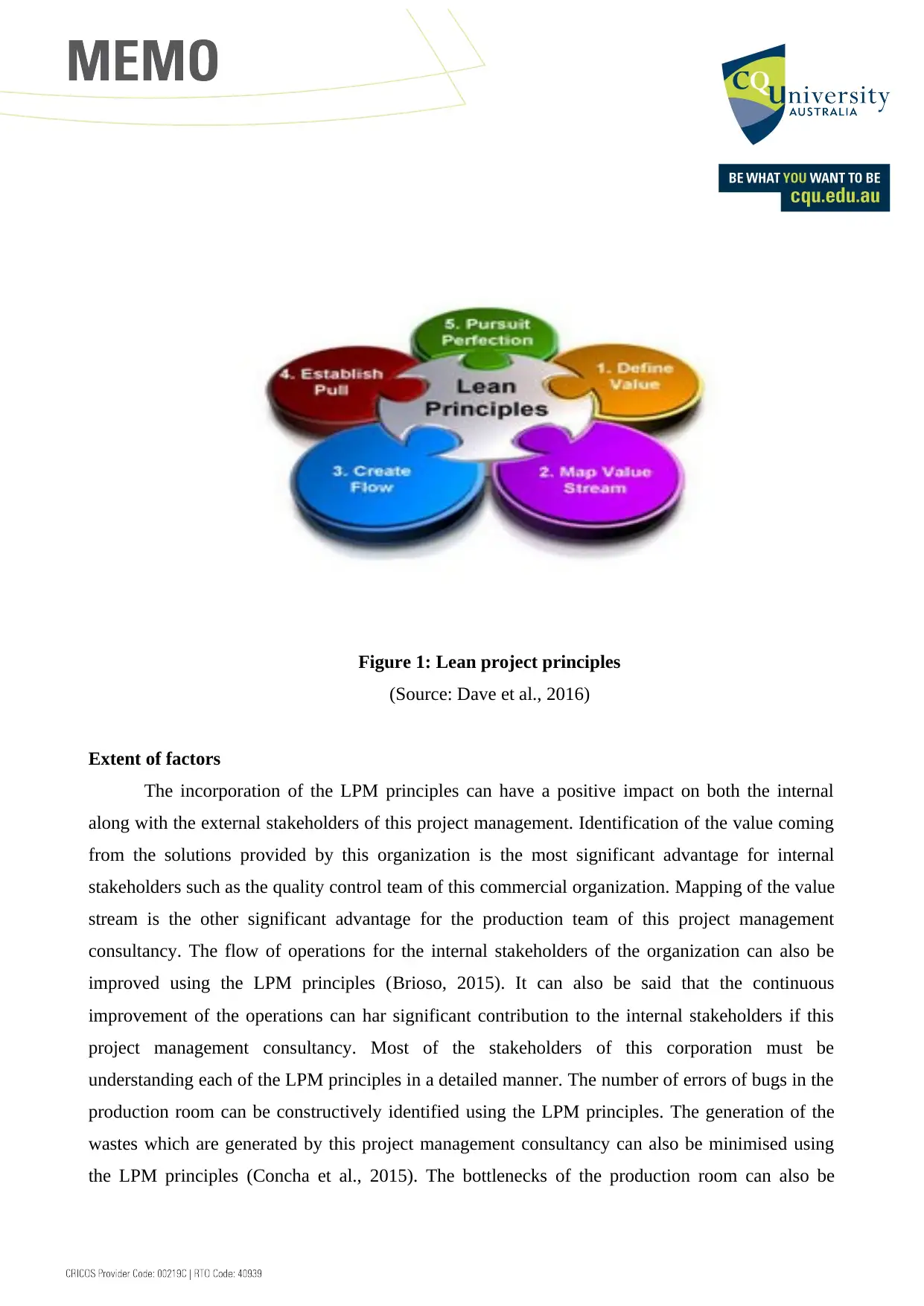
Figure 1: Lean project principles
(Source: Dave et al., 2016)
Extent of factors
The incorporation of the LPM principles can have a positive impact on both the internal
along with the external stakeholders of this project management. Identification of the value coming
from the solutions provided by this organization is the most significant advantage for internal
stakeholders such as the quality control team of this commercial organization. Mapping of the value
stream is the other significant advantage for the production team of this project management
consultancy. The flow of operations for the internal stakeholders of the organization can also be
improved using the LPM principles (Brioso, 2015). It can also be said that the continuous
improvement of the operations can har significant contribution to the internal stakeholders if this
project management consultancy. Most of the stakeholders of this corporation must be
understanding each of the LPM principles in a detailed manner. The number of errors of bugs in the
production room can be constructively identified using the LPM principles. The generation of the
wastes which are generated by this project management consultancy can also be minimised using
the LPM principles (Concha et al., 2015). The bottlenecks of the production room can also be
(Source: Dave et al., 2016)
Extent of factors
The incorporation of the LPM principles can have a positive impact on both the internal
along with the external stakeholders of this project management. Identification of the value coming
from the solutions provided by this organization is the most significant advantage for internal
stakeholders such as the quality control team of this commercial organization. Mapping of the value
stream is the other significant advantage for the production team of this project management
consultancy. The flow of operations for the internal stakeholders of the organization can also be
improved using the LPM principles (Brioso, 2015). It can also be said that the continuous
improvement of the operations can har significant contribution to the internal stakeholders if this
project management consultancy. Most of the stakeholders of this corporation must be
understanding each of the LPM principles in a detailed manner. The number of errors of bugs in the
production room can be constructively identified using the LPM principles. The generation of the
wastes which are generated by this project management consultancy can also be minimised using
the LPM principles (Concha et al., 2015). The bottlenecks of the production room can also be
Paraphrase This Document
Need a fresh take? Get an instant paraphrase of this document with our AI Paraphraser
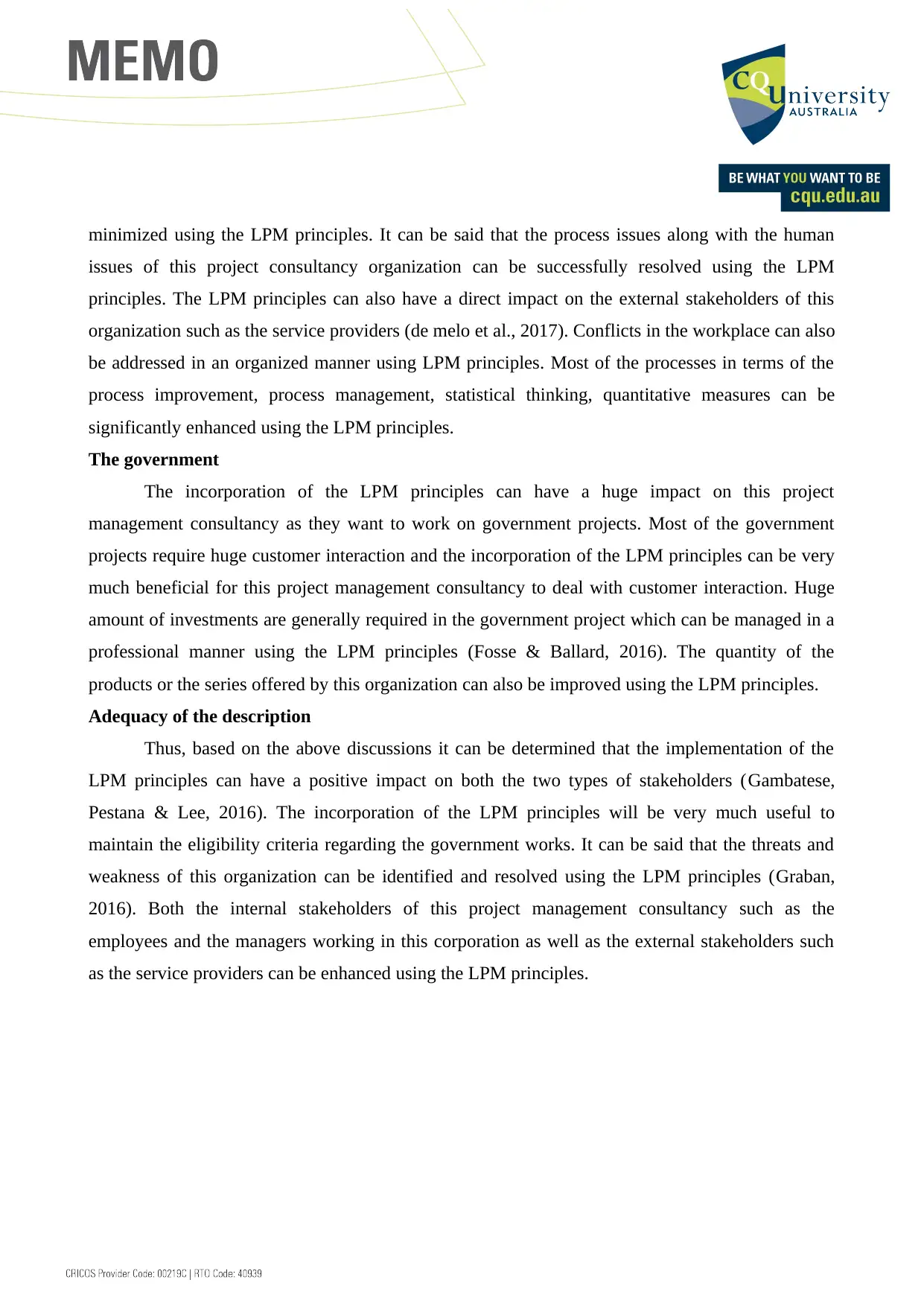
minimized using the LPM principles. It can be said that the process issues along with the human
issues of this project consultancy organization can be successfully resolved using the LPM
principles. The LPM principles can also have a direct impact on the external stakeholders of this
organization such as the service providers (de melo et al., 2017). Conflicts in the workplace can also
be addressed in an organized manner using LPM principles. Most of the processes in terms of the
process improvement, process management, statistical thinking, quantitative measures can be
significantly enhanced using the LPM principles.
The government
The incorporation of the LPM principles can have a huge impact on this project
management consultancy as they want to work on government projects. Most of the government
projects require huge customer interaction and the incorporation of the LPM principles can be very
much beneficial for this project management consultancy to deal with customer interaction. Huge
amount of investments are generally required in the government project which can be managed in a
professional manner using the LPM principles (Fosse & Ballard, 2016). The quantity of the
products or the series offered by this organization can also be improved using the LPM principles.
Adequacy of the description
Thus, based on the above discussions it can be determined that the implementation of the
LPM principles can have a positive impact on both the two types of stakeholders (Gambatese,
Pestana & Lee, 2016). The incorporation of the LPM principles will be very much useful to
maintain the eligibility criteria regarding the government works. It can be said that the threats and
weakness of this organization can be identified and resolved using the LPM principles (Graban,
2016). Both the internal stakeholders of this project management consultancy such as the
employees and the managers working in this corporation as well as the external stakeholders such
as the service providers can be enhanced using the LPM principles.
issues of this project consultancy organization can be successfully resolved using the LPM
principles. The LPM principles can also have a direct impact on the external stakeholders of this
organization such as the service providers (de melo et al., 2017). Conflicts in the workplace can also
be addressed in an organized manner using LPM principles. Most of the processes in terms of the
process improvement, process management, statistical thinking, quantitative measures can be
significantly enhanced using the LPM principles.
The government
The incorporation of the LPM principles can have a huge impact on this project
management consultancy as they want to work on government projects. Most of the government
projects require huge customer interaction and the incorporation of the LPM principles can be very
much beneficial for this project management consultancy to deal with customer interaction. Huge
amount of investments are generally required in the government project which can be managed in a
professional manner using the LPM principles (Fosse & Ballard, 2016). The quantity of the
products or the series offered by this organization can also be improved using the LPM principles.
Adequacy of the description
Thus, based on the above discussions it can be determined that the implementation of the
LPM principles can have a positive impact on both the two types of stakeholders (Gambatese,
Pestana & Lee, 2016). The incorporation of the LPM principles will be very much useful to
maintain the eligibility criteria regarding the government works. It can be said that the threats and
weakness of this organization can be identified and resolved using the LPM principles (Graban,
2016). Both the internal stakeholders of this project management consultancy such as the
employees and the managers working in this corporation as well as the external stakeholders such
as the service providers can be enhanced using the LPM principles.
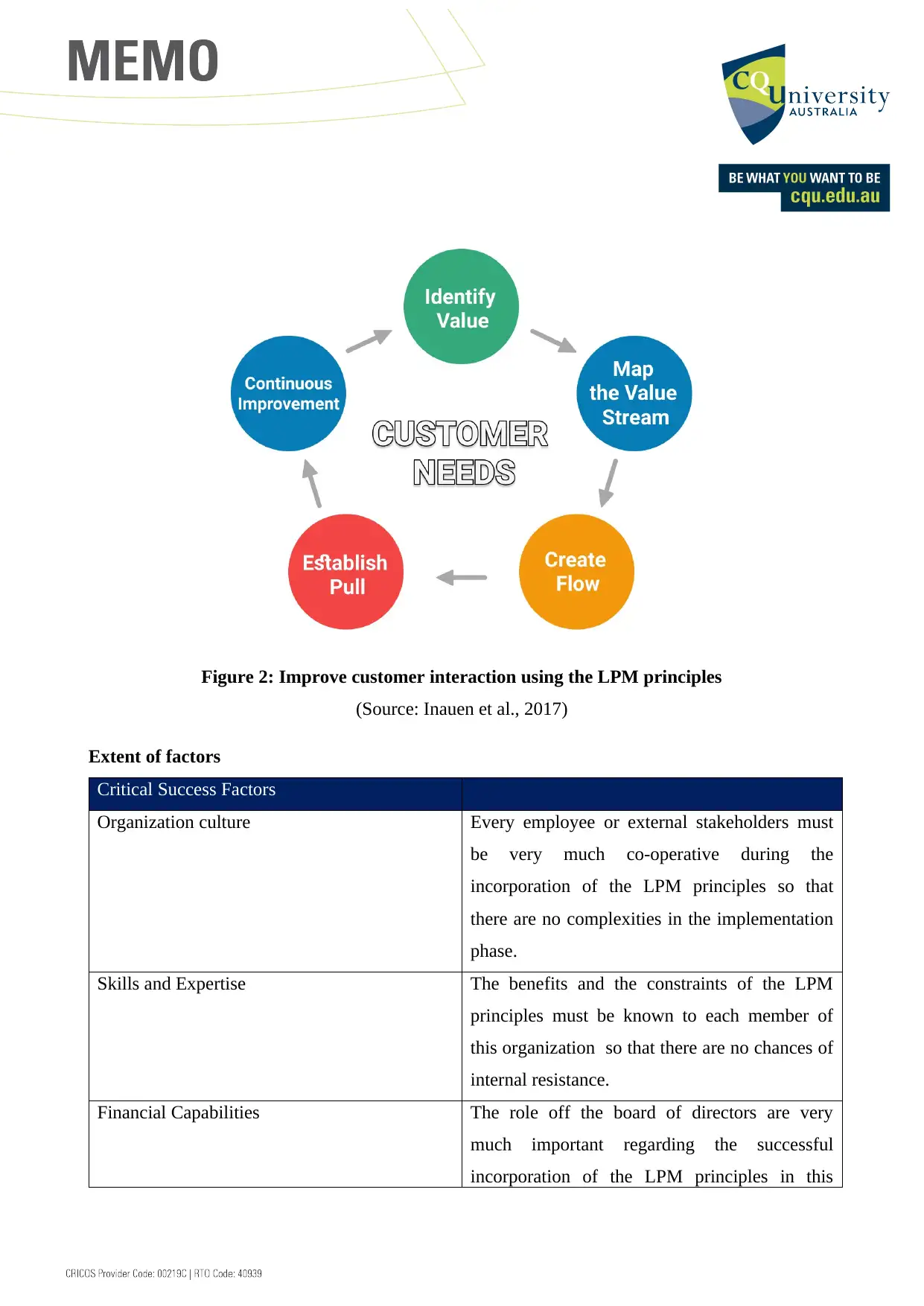
Figure 2: Improve customer interaction using the LPM principles
(Source: Inauen et al., 2017)
Extent of factors
Critical Success Factors
Organization culture Every employee or external stakeholders must
be very much co-operative during the
incorporation of the LPM principles so that
there are no complexities in the implementation
phase.
Skills and Expertise The benefits and the constraints of the LPM
principles must be known to each member of
this organization so that there are no chances of
internal resistance.
Financial Capabilities The role off the board of directors are very
much important regarding the successful
incorporation of the LPM principles in this
(Source: Inauen et al., 2017)
Extent of factors
Critical Success Factors
Organization culture Every employee or external stakeholders must
be very much co-operative during the
incorporation of the LPM principles so that
there are no complexities in the implementation
phase.
Skills and Expertise The benefits and the constraints of the LPM
principles must be known to each member of
this organization so that there are no chances of
internal resistance.
Financial Capabilities The role off the board of directors are very
much important regarding the successful
incorporation of the LPM principles in this
⊘ This is a preview!⊘
Do you want full access?
Subscribe today to unlock all pages.

Trusted by 1+ million students worldwide
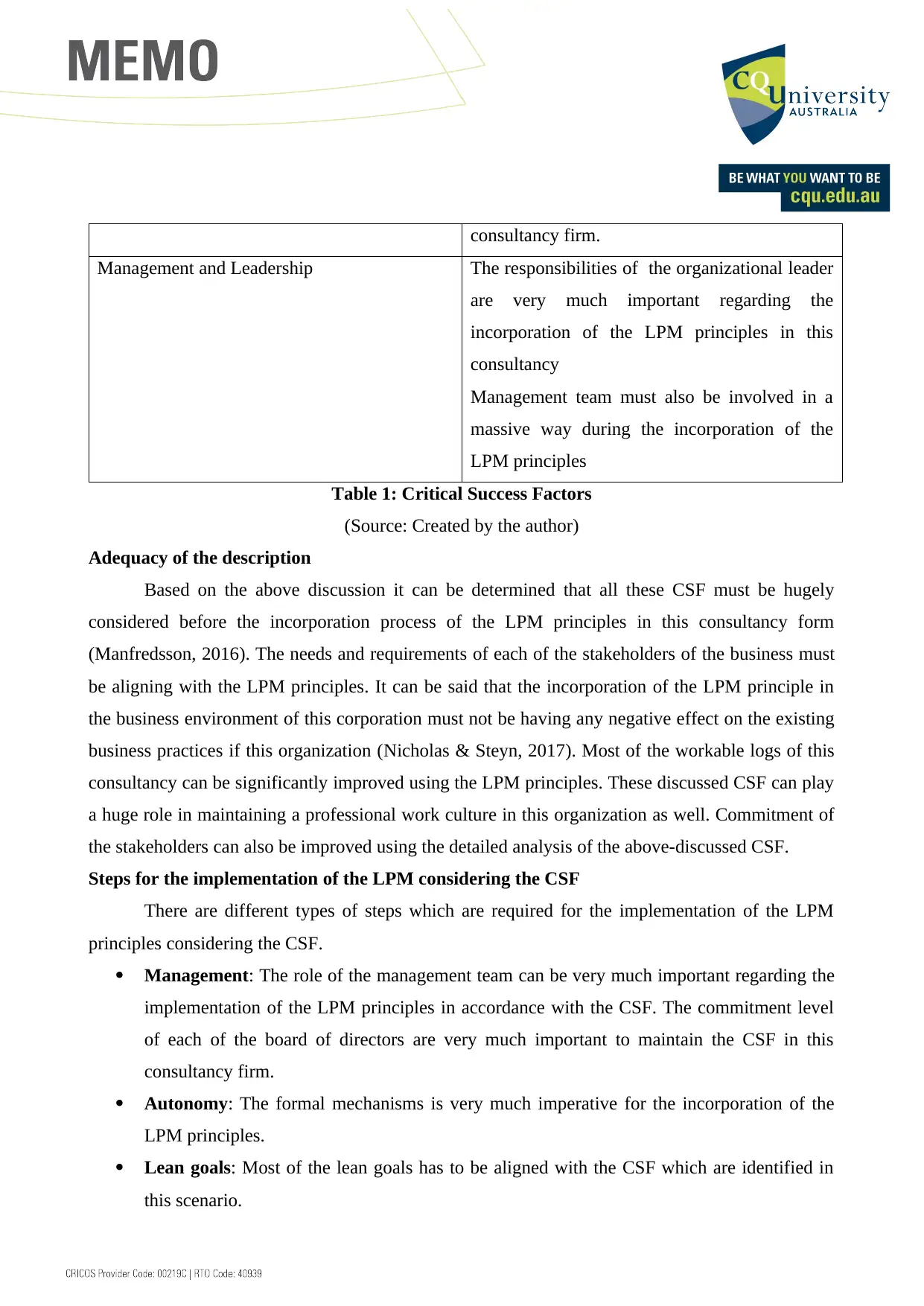
consultancy firm.
Management and Leadership The responsibilities of the organizational leader
are very much important regarding the
incorporation of the LPM principles in this
consultancy
Management team must also be involved in a
massive way during the incorporation of the
LPM principles
Table 1: Critical Success Factors
(Source: Created by the author)
Adequacy of the description
Based on the above discussion it can be determined that all these CSF must be hugely
considered before the incorporation process of the LPM principles in this consultancy form
(Manfredsson, 2016). The needs and requirements of each of the stakeholders of the business must
be aligning with the LPM principles. It can be said that the incorporation of the LPM principle in
the business environment of this corporation must not be having any negative effect on the existing
business practices if this organization (Nicholas & Steyn, 2017). Most of the workable logs of this
consultancy can be significantly improved using the LPM principles. These discussed CSF can play
a huge role in maintaining a professional work culture in this organization as well. Commitment of
the stakeholders can also be improved using the detailed analysis of the above-discussed CSF.
Steps for the implementation of the LPM considering the CSF
There are different types of steps which are required for the implementation of the LPM
principles considering the CSF.
Management: The role of the management team can be very much important regarding the
implementation of the LPM principles in accordance with the CSF. The commitment level
of each of the board of directors are very much important to maintain the CSF in this
consultancy firm.
Autonomy: The formal mechanisms is very much imperative for the incorporation of the
LPM principles.
Lean goals: Most of the lean goals has to be aligned with the CSF which are identified in
this scenario.
Management and Leadership The responsibilities of the organizational leader
are very much important regarding the
incorporation of the LPM principles in this
consultancy
Management team must also be involved in a
massive way during the incorporation of the
LPM principles
Table 1: Critical Success Factors
(Source: Created by the author)
Adequacy of the description
Based on the above discussion it can be determined that all these CSF must be hugely
considered before the incorporation process of the LPM principles in this consultancy form
(Manfredsson, 2016). The needs and requirements of each of the stakeholders of the business must
be aligning with the LPM principles. It can be said that the incorporation of the LPM principle in
the business environment of this corporation must not be having any negative effect on the existing
business practices if this organization (Nicholas & Steyn, 2017). Most of the workable logs of this
consultancy can be significantly improved using the LPM principles. These discussed CSF can play
a huge role in maintaining a professional work culture in this organization as well. Commitment of
the stakeholders can also be improved using the detailed analysis of the above-discussed CSF.
Steps for the implementation of the LPM considering the CSF
There are different types of steps which are required for the implementation of the LPM
principles considering the CSF.
Management: The role of the management team can be very much important regarding the
implementation of the LPM principles in accordance with the CSF. The commitment level
of each of the board of directors are very much important to maintain the CSF in this
consultancy firm.
Autonomy: The formal mechanisms is very much imperative for the incorporation of the
LPM principles.
Lean goals: Most of the lean goals has to be aligned with the CSF which are identified in
this scenario.
Paraphrase This Document
Need a fresh take? Get an instant paraphrase of this document with our AI Paraphraser
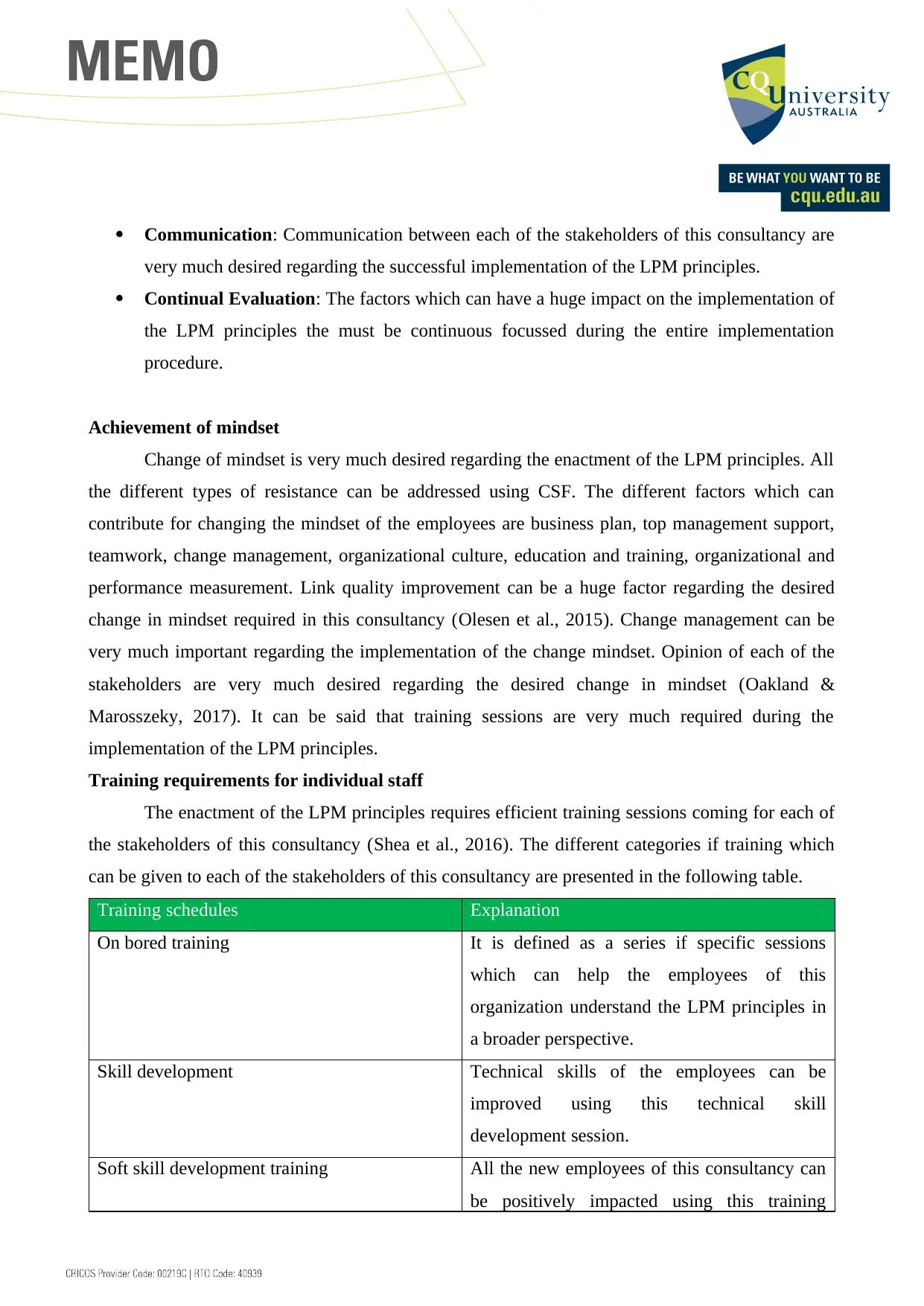
Communication: Communication between each of the stakeholders of this consultancy are
very much desired regarding the successful implementation of the LPM principles.
Continual Evaluation: The factors which can have a huge impact on the implementation of
the LPM principles the must be continuous focussed during the entire implementation
procedure.
Achievement of mindset
Change of mindset is very much desired regarding the enactment of the LPM principles. All
the different types of resistance can be addressed using CSF. The different factors which can
contribute for changing the mindset of the employees are business plan, top management support,
teamwork, change management, organizational culture, education and training, organizational and
performance measurement. Link quality improvement can be a huge factor regarding the desired
change in mindset required in this consultancy (Olesen et al., 2015). Change management can be
very much important regarding the implementation of the change mindset. Opinion of each of the
stakeholders are very much desired regarding the desired change in mindset (Oakland &
Marosszeky, 2017). It can be said that training sessions are very much required during the
implementation of the LPM principles.
Training requirements for individual staff
The enactment of the LPM principles requires efficient training sessions coming for each of
the stakeholders of this consultancy (Shea et al., 2016). The different categories if training which
can be given to each of the stakeholders of this consultancy are presented in the following table.
Training schedules Explanation
On bored training It is defined as a series if specific sessions
which can help the employees of this
organization understand the LPM principles in
a broader perspective.
Skill development Technical skills of the employees can be
improved using this technical skill
development session.
Soft skill development training All the new employees of this consultancy can
be positively impacted using this training
very much desired regarding the successful implementation of the LPM principles.
Continual Evaluation: The factors which can have a huge impact on the implementation of
the LPM principles the must be continuous focussed during the entire implementation
procedure.
Achievement of mindset
Change of mindset is very much desired regarding the enactment of the LPM principles. All
the different types of resistance can be addressed using CSF. The different factors which can
contribute for changing the mindset of the employees are business plan, top management support,
teamwork, change management, organizational culture, education and training, organizational and
performance measurement. Link quality improvement can be a huge factor regarding the desired
change in mindset required in this consultancy (Olesen et al., 2015). Change management can be
very much important regarding the implementation of the change mindset. Opinion of each of the
stakeholders are very much desired regarding the desired change in mindset (Oakland &
Marosszeky, 2017). It can be said that training sessions are very much required during the
implementation of the LPM principles.
Training requirements for individual staff
The enactment of the LPM principles requires efficient training sessions coming for each of
the stakeholders of this consultancy (Shea et al., 2016). The different categories if training which
can be given to each of the stakeholders of this consultancy are presented in the following table.
Training schedules Explanation
On bored training It is defined as a series if specific sessions
which can help the employees of this
organization understand the LPM principles in
a broader perspective.
Skill development Technical skills of the employees can be
improved using this technical skill
development session.
Soft skill development training All the new employees of this consultancy can
be positively impacted using this training
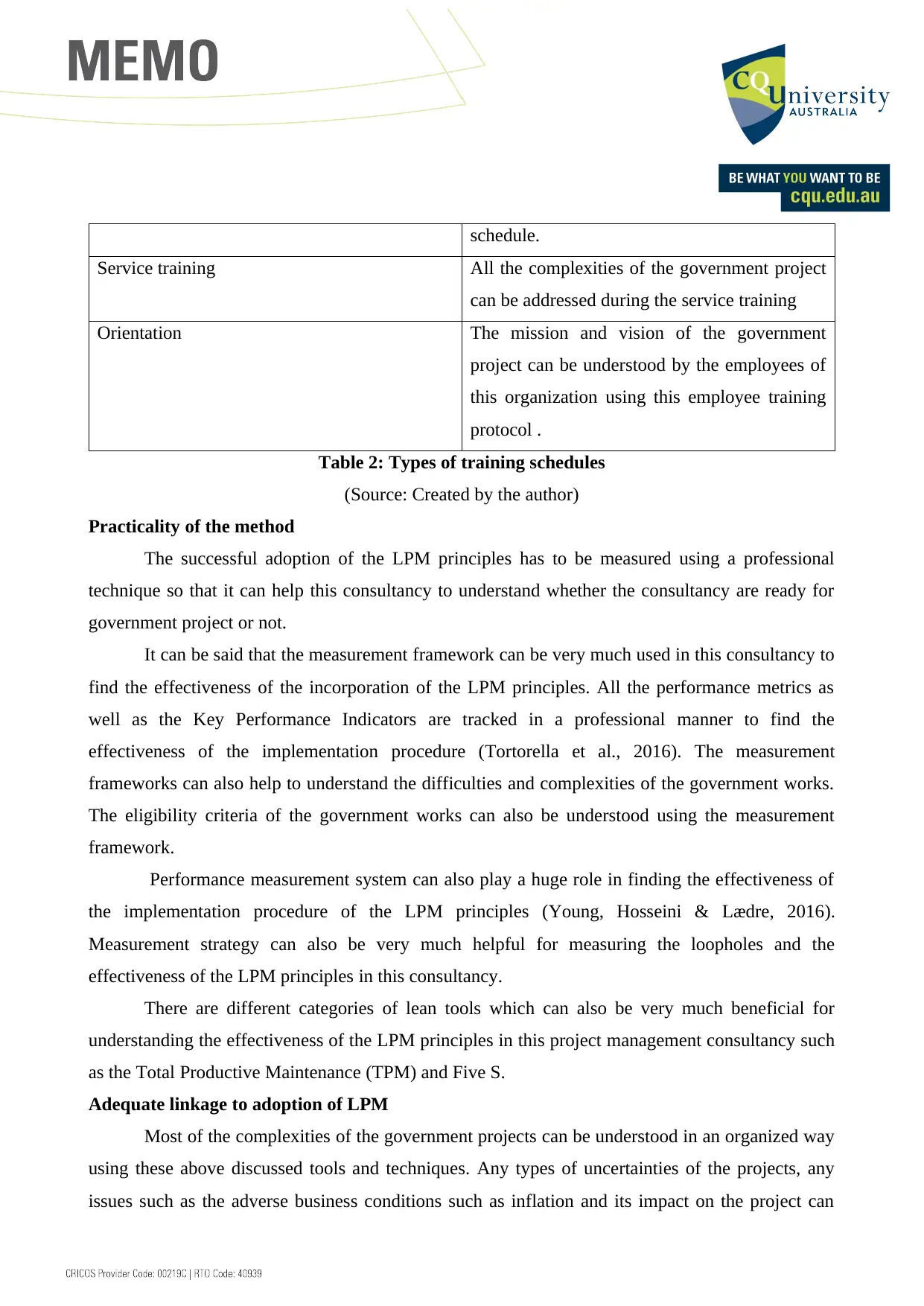
schedule.
Service training All the complexities of the government project
can be addressed during the service training
Orientation The mission and vision of the government
project can be understood by the employees of
this organization using this employee training
protocol .
Table 2: Types of training schedules
(Source: Created by the author)
Practicality of the method
The successful adoption of the LPM principles has to be measured using a professional
technique so that it can help this consultancy to understand whether the consultancy are ready for
government project or not.
It can be said that the measurement framework can be very much used in this consultancy to
find the effectiveness of the incorporation of the LPM principles. All the performance metrics as
well as the Key Performance Indicators are tracked in a professional manner to find the
effectiveness of the implementation procedure (Tortorella et al., 2016). The measurement
frameworks can also help to understand the difficulties and complexities of the government works.
The eligibility criteria of the government works can also be understood using the measurement
framework.
Performance measurement system can also play a huge role in finding the effectiveness of
the implementation procedure of the LPM principles (Young, Hosseini & Lædre, 2016).
Measurement strategy can also be very much helpful for measuring the loopholes and the
effectiveness of the LPM principles in this consultancy.
There are different categories of lean tools which can also be very much beneficial for
understanding the effectiveness of the LPM principles in this project management consultancy such
as the Total Productive Maintenance (TPM) and Five S.
Adequate linkage to adoption of LPM
Most of the complexities of the government projects can be understood in an organized way
using these above discussed tools and techniques. Any types of uncertainties of the projects, any
issues such as the adverse business conditions such as inflation and its impact on the project can
Service training All the complexities of the government project
can be addressed during the service training
Orientation The mission and vision of the government
project can be understood by the employees of
this organization using this employee training
protocol .
Table 2: Types of training schedules
(Source: Created by the author)
Practicality of the method
The successful adoption of the LPM principles has to be measured using a professional
technique so that it can help this consultancy to understand whether the consultancy are ready for
government project or not.
It can be said that the measurement framework can be very much used in this consultancy to
find the effectiveness of the incorporation of the LPM principles. All the performance metrics as
well as the Key Performance Indicators are tracked in a professional manner to find the
effectiveness of the implementation procedure (Tortorella et al., 2016). The measurement
frameworks can also help to understand the difficulties and complexities of the government works.
The eligibility criteria of the government works can also be understood using the measurement
framework.
Performance measurement system can also play a huge role in finding the effectiveness of
the implementation procedure of the LPM principles (Young, Hosseini & Lædre, 2016).
Measurement strategy can also be very much helpful for measuring the loopholes and the
effectiveness of the LPM principles in this consultancy.
There are different categories of lean tools which can also be very much beneficial for
understanding the effectiveness of the LPM principles in this project management consultancy such
as the Total Productive Maintenance (TPM) and Five S.
Adequate linkage to adoption of LPM
Most of the complexities of the government projects can be understood in an organized way
using these above discussed tools and techniques. Any types of uncertainties of the projects, any
issues such as the adverse business conditions such as inflation and its impact on the project can
⊘ This is a preview!⊘
Do you want full access?
Subscribe today to unlock all pages.

Trusted by 1+ million students worldwide
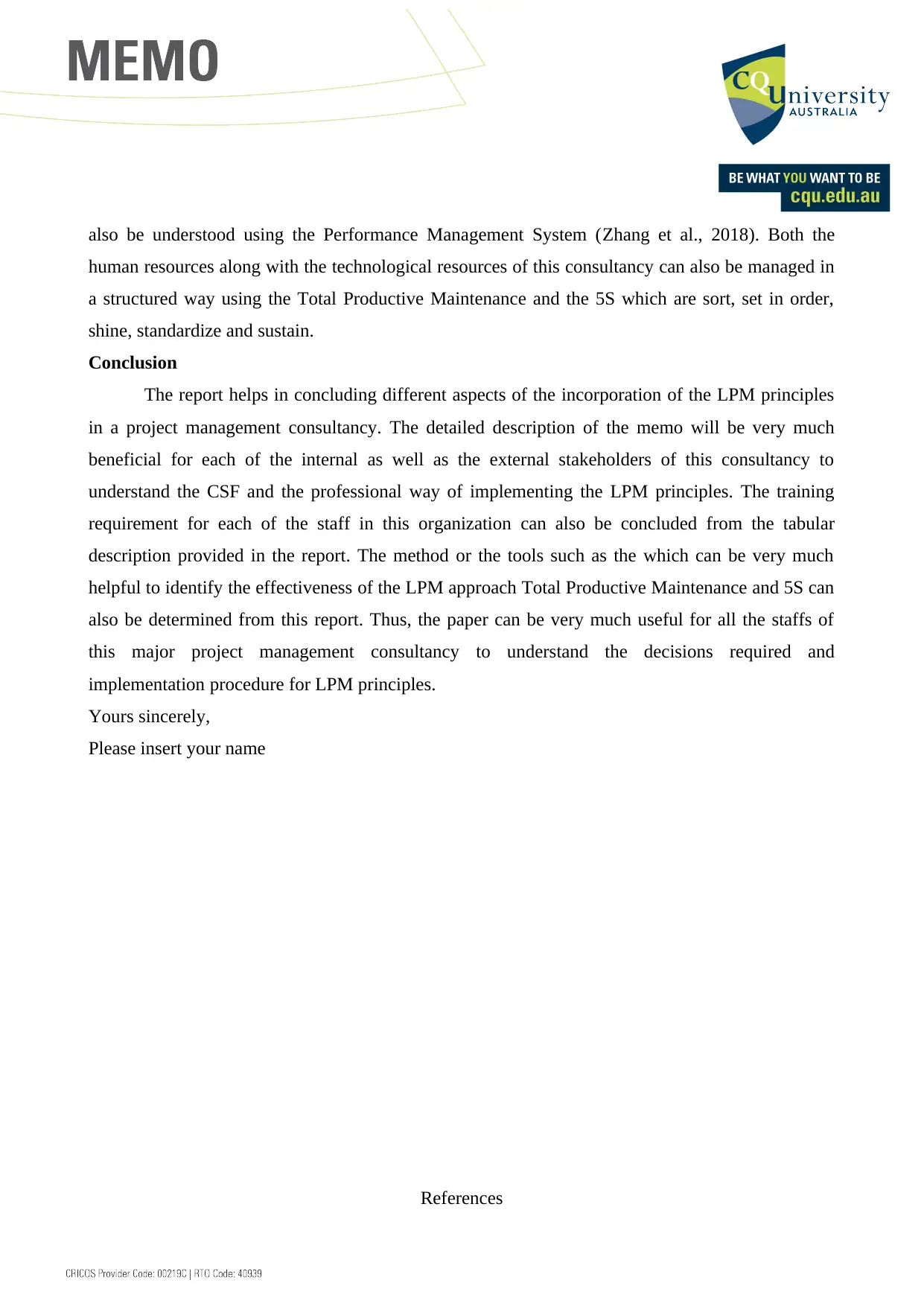
also be understood using the Performance Management System (Zhang et al., 2018). Both the
human resources along with the technological resources of this consultancy can also be managed in
a structured way using the Total Productive Maintenance and the 5S which are sort, set in order,
shine, standardize and sustain.
Conclusion
The report helps in concluding different aspects of the incorporation of the LPM principles
in a project management consultancy. The detailed description of the memo will be very much
beneficial for each of the internal as well as the external stakeholders of this consultancy to
understand the CSF and the professional way of implementing the LPM principles. The training
requirement for each of the staff in this organization can also be concluded from the tabular
description provided in the report. The method or the tools such as the which can be very much
helpful to identify the effectiveness of the LPM approach Total Productive Maintenance and 5S can
also be determined from this report. Thus, the paper can be very much useful for all the staffs of
this major project management consultancy to understand the decisions required and
implementation procedure for LPM principles.
Yours sincerely,
Please insert your name
References
human resources along with the technological resources of this consultancy can also be managed in
a structured way using the Total Productive Maintenance and the 5S which are sort, set in order,
shine, standardize and sustain.
Conclusion
The report helps in concluding different aspects of the incorporation of the LPM principles
in a project management consultancy. The detailed description of the memo will be very much
beneficial for each of the internal as well as the external stakeholders of this consultancy to
understand the CSF and the professional way of implementing the LPM principles. The training
requirement for each of the staff in this organization can also be concluded from the tabular
description provided in the report. The method or the tools such as the which can be very much
helpful to identify the effectiveness of the LPM approach Total Productive Maintenance and 5S can
also be determined from this report. Thus, the paper can be very much useful for all the staffs of
this major project management consultancy to understand the decisions required and
implementation procedure for LPM principles.
Yours sincerely,
Please insert your name
References
Paraphrase This Document
Need a fresh take? Get an instant paraphrase of this document with our AI Paraphraser
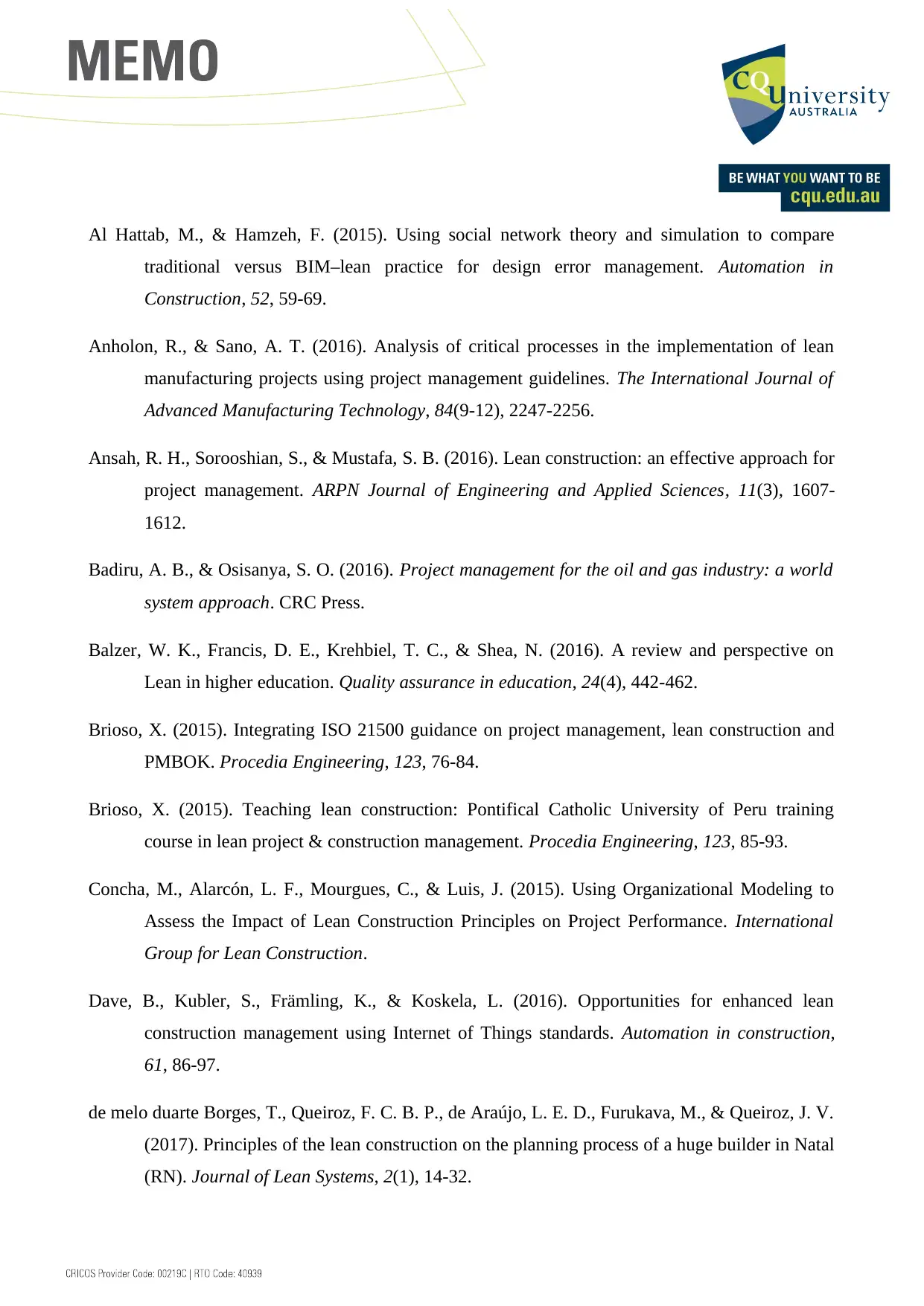
Al Hattab, M., & Hamzeh, F. (2015). Using social network theory and simulation to compare
traditional versus BIM–lean practice for design error management. Automation in
Construction, 52, 59-69.
Anholon, R., & Sano, A. T. (2016). Analysis of critical processes in the implementation of lean
manufacturing projects using project management guidelines. The International Journal of
Advanced Manufacturing Technology, 84(9-12), 2247-2256.
Ansah, R. H., Sorooshian, S., & Mustafa, S. B. (2016). Lean construction: an effective approach for
project management. ARPN Journal of Engineering and Applied Sciences, 11(3), 1607-
1612.
Badiru, A. B., & Osisanya, S. O. (2016). Project management for the oil and gas industry: a world
system approach. CRC Press.
Balzer, W. K., Francis, D. E., Krehbiel, T. C., & Shea, N. (2016). A review and perspective on
Lean in higher education. Quality assurance in education, 24(4), 442-462.
Brioso, X. (2015). Integrating ISO 21500 guidance on project management, lean construction and
PMBOK. Procedia Engineering, 123, 76-84.
Brioso, X. (2015). Teaching lean construction: Pontifical Catholic University of Peru training
course in lean project & construction management. Procedia Engineering, 123, 85-93.
Concha, M., Alarcón, L. F., Mourgues, C., & Luis, J. (2015). Using Organizational Modeling to
Assess the Impact of Lean Construction Principles on Project Performance. International
Group for Lean Construction.
Dave, B., Kubler, S., Främling, K., & Koskela, L. (2016). Opportunities for enhanced lean
construction management using Internet of Things standards. Automation in construction,
61, 86-97.
de melo duarte Borges, T., Queiroz, F. C. B. P., de Araújo, L. E. D., Furukava, M., & Queiroz, J. V.
(2017). Principles of the lean construction on the planning process of a huge builder in Natal
(RN). Journal of Lean Systems, 2(1), 14-32.
traditional versus BIM–lean practice for design error management. Automation in
Construction, 52, 59-69.
Anholon, R., & Sano, A. T. (2016). Analysis of critical processes in the implementation of lean
manufacturing projects using project management guidelines. The International Journal of
Advanced Manufacturing Technology, 84(9-12), 2247-2256.
Ansah, R. H., Sorooshian, S., & Mustafa, S. B. (2016). Lean construction: an effective approach for
project management. ARPN Journal of Engineering and Applied Sciences, 11(3), 1607-
1612.
Badiru, A. B., & Osisanya, S. O. (2016). Project management for the oil and gas industry: a world
system approach. CRC Press.
Balzer, W. K., Francis, D. E., Krehbiel, T. C., & Shea, N. (2016). A review and perspective on
Lean in higher education. Quality assurance in education, 24(4), 442-462.
Brioso, X. (2015). Integrating ISO 21500 guidance on project management, lean construction and
PMBOK. Procedia Engineering, 123, 76-84.
Brioso, X. (2015). Teaching lean construction: Pontifical Catholic University of Peru training
course in lean project & construction management. Procedia Engineering, 123, 85-93.
Concha, M., Alarcón, L. F., Mourgues, C., & Luis, J. (2015). Using Organizational Modeling to
Assess the Impact of Lean Construction Principles on Project Performance. International
Group for Lean Construction.
Dave, B., Kubler, S., Främling, K., & Koskela, L. (2016). Opportunities for enhanced lean
construction management using Internet of Things standards. Automation in construction,
61, 86-97.
de melo duarte Borges, T., Queiroz, F. C. B. P., de Araújo, L. E. D., Furukava, M., & Queiroz, J. V.
(2017). Principles of the lean construction on the planning process of a huge builder in Natal
(RN). Journal of Lean Systems, 2(1), 14-32.
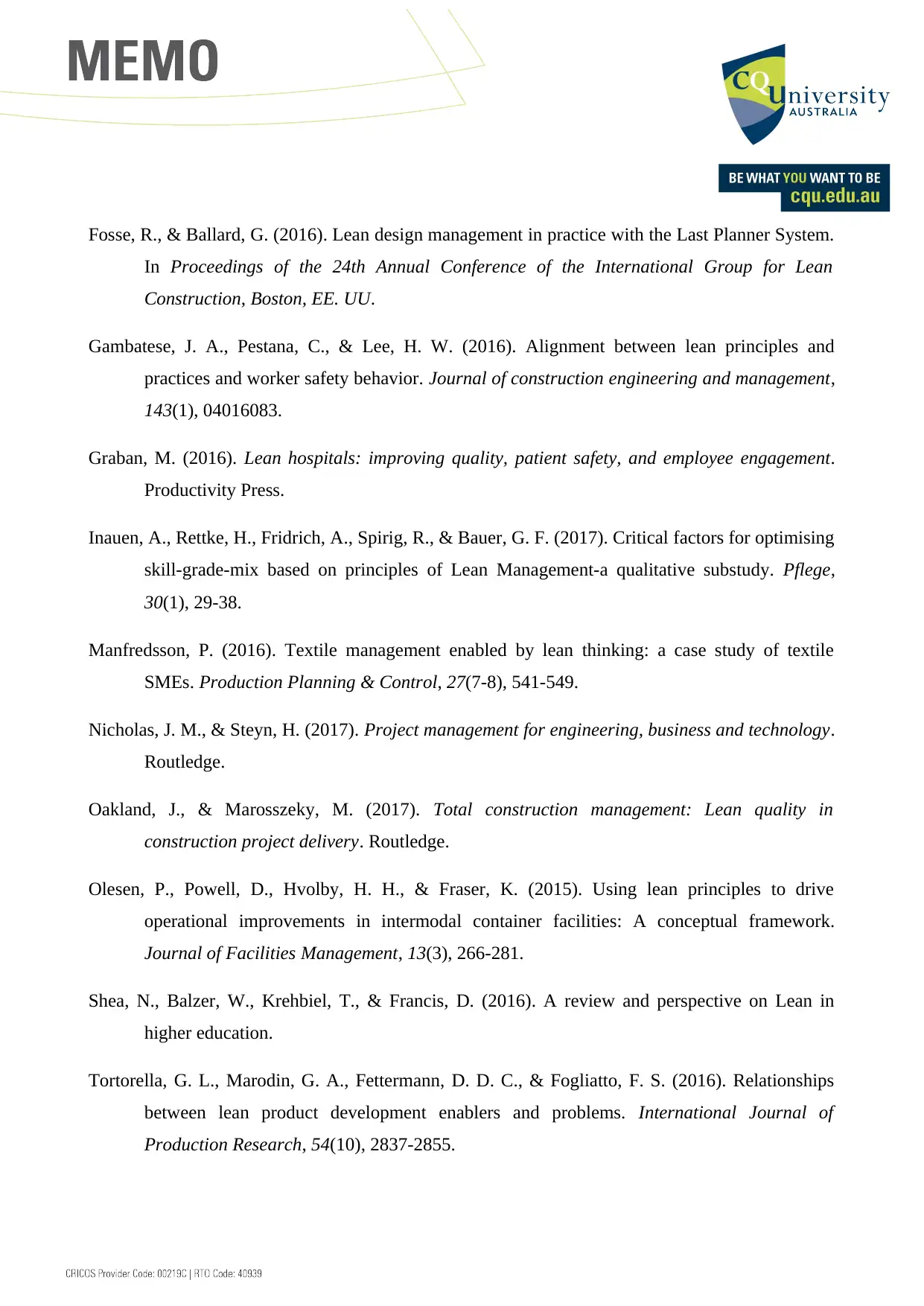
Fosse, R., & Ballard, G. (2016). Lean design management in practice with the Last Planner System.
In Proceedings of the 24th Annual Conference of the International Group for Lean
Construction, Boston, EE. UU.
Gambatese, J. A., Pestana, C., & Lee, H. W. (2016). Alignment between lean principles and
practices and worker safety behavior. Journal of construction engineering and management,
143(1), 04016083.
Graban, M. (2016). Lean hospitals: improving quality, patient safety, and employee engagement.
Productivity Press.
Inauen, A., Rettke, H., Fridrich, A., Spirig, R., & Bauer, G. F. (2017). Critical factors for optimising
skill-grade-mix based on principles of Lean Management-a qualitative substudy. Pflege,
30(1), 29-38.
Manfredsson, P. (2016). Textile management enabled by lean thinking: a case study of textile
SMEs. Production Planning & Control, 27(7-8), 541-549.
Nicholas, J. M., & Steyn, H. (2017). Project management for engineering, business and technology.
Routledge.
Oakland, J., & Marosszeky, M. (2017). Total construction management: Lean quality in
construction project delivery. Routledge.
Olesen, P., Powell, D., Hvolby, H. H., & Fraser, K. (2015). Using lean principles to drive
operational improvements in intermodal container facilities: A conceptual framework.
Journal of Facilities Management, 13(3), 266-281.
Shea, N., Balzer, W., Krehbiel, T., & Francis, D. (2016). A review and perspective on Lean in
higher education.
Tortorella, G. L., Marodin, G. A., Fettermann, D. D. C., & Fogliatto, F. S. (2016). Relationships
between lean product development enablers and problems. International Journal of
Production Research, 54(10), 2837-2855.
In Proceedings of the 24th Annual Conference of the International Group for Lean
Construction, Boston, EE. UU.
Gambatese, J. A., Pestana, C., & Lee, H. W. (2016). Alignment between lean principles and
practices and worker safety behavior. Journal of construction engineering and management,
143(1), 04016083.
Graban, M. (2016). Lean hospitals: improving quality, patient safety, and employee engagement.
Productivity Press.
Inauen, A., Rettke, H., Fridrich, A., Spirig, R., & Bauer, G. F. (2017). Critical factors for optimising
skill-grade-mix based on principles of Lean Management-a qualitative substudy. Pflege,
30(1), 29-38.
Manfredsson, P. (2016). Textile management enabled by lean thinking: a case study of textile
SMEs. Production Planning & Control, 27(7-8), 541-549.
Nicholas, J. M., & Steyn, H. (2017). Project management for engineering, business and technology.
Routledge.
Oakland, J., & Marosszeky, M. (2017). Total construction management: Lean quality in
construction project delivery. Routledge.
Olesen, P., Powell, D., Hvolby, H. H., & Fraser, K. (2015). Using lean principles to drive
operational improvements in intermodal container facilities: A conceptual framework.
Journal of Facilities Management, 13(3), 266-281.
Shea, N., Balzer, W., Krehbiel, T., & Francis, D. (2016). A review and perspective on Lean in
higher education.
Tortorella, G. L., Marodin, G. A., Fettermann, D. D. C., & Fogliatto, F. S. (2016). Relationships
between lean product development enablers and problems. International Journal of
Production Research, 54(10), 2837-2855.
⊘ This is a preview!⊘
Do you want full access?
Subscribe today to unlock all pages.

Trusted by 1+ million students worldwide
1 out of 13
Related Documents
Your All-in-One AI-Powered Toolkit for Academic Success.
+13062052269
info@desklib.com
Available 24*7 on WhatsApp / Email
![[object Object]](/_next/static/media/star-bottom.7253800d.svg)
Unlock your academic potential
Copyright © 2020–2025 A2Z Services. All Rights Reserved. Developed and managed by ZUCOL.




